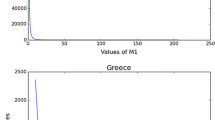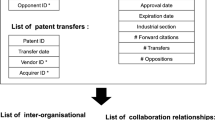Abstract
Firms participating in a patent transaction network demonstrate interdependence and mutually influence one another. The characteristics of such a network structure demonstrate a complex overall configuration. This study proposes a dynamic perspective for investigating the structure of a patent transaction network. By using network analysis, this study defines the structural configuration of a patent transaction network by measuring centralization, centrality, and linkage distribution. Data from patent transactions of the flat panel display sector from 1976 to 2012 have been examined evaluate their networking. The results show that the structural configuration of a patent transaction network shows significant stratification patterns in terms of a given firm’s technology exportation and brokerage capabilities, but also operates as a complex system. This analysis provides insights into patent transaction networks, and also addresses policy implications for firms and authorities who are interested in acquiring market competition or governance.


Similar content being viewed by others
Notes
TFT-LCD specific manufacturing technology can be further divided as Twisted nematic (TN), In-Plane Switching (IPS), Advanced fringe field switching (AFFS), Multi-domain vertical alignment (MVA), Patterned vertical alignment (PVA), Advanced super view (ASV), Plane Line Switching (PLS), and TFT dual-transistor pixel (DTP).
References
Amaral, L. A. N., Scala, A., Barthélémy, M., & Stanley, H. E. (2000). Classes of small-world networks. Proceedings of the National Academy of Sciences, 97(21), 11149–11152. doi:10.1073/pnas.200327197.
Anokhin, S., & Wincent, J. (2014). Technological arbitrage opportunities and interindustry differences in entry rates. Journal of Business Venturing, 29(3), 437–452. doi:10.1016/j.jbusvent.2013.07.002.
Arora, A., Fosfuri, A., & Gambardella, A. (2001). Markets for technology and their implications for corporate strategy. Industrial and Corporate Change, 10(2), 419–451. doi:10.2139/ssrn.204848.
Barabási, A.-L., & Albert, R. (1999). Emergence of scaling in random networks. Science, 286(5439), 509–512. doi:10.1126/science.286.5439.509.
Barabási, A.-L., & Bonabeau, E. (2003). Scale-free networks. Scientific American. doi:10.1038/scientificamerican0503-60.
Barabási, A.-L., Jeong, H., Neda, Z., Ravasz, E., Schubert, A., & Vicsek, T. (2002). Evolution of the social network of scientific collaborations. Physica A: Statistical Mechanics and its Applications, 311, 590–614. doi:10.1016/s0378-4371(02)00736-7.
Bar-Yam, Y. (2003). Dynamics of complex systems (studies in nonlinearity). Nashville, TN: Westview Press.
Bleda, M., & del Río, P. (2013). The market failure and the systemic failure rationales in technological innovation systems. Research Policy, 42(5), 1039–1052. doi:10.1016/j.respol.2013.02.008.
Brody, T. P. (1996). The birth and early childhood of active matrix—A personal memoir. Journal of the Society for Information Display, 4(3), 113–127. doi:10.1889/1.1985000.
Burt, R. S. (2004). Structural holes and good ideas. American Journal of Sociology, 110(2), 349–399. doi:10.1086/421787.
Burt, R. S. (2005). Brokerage and closure: An introduction to social capital. Oxford: Oxford University Press.
Chesbrough, H. (2003). The logic of open innovation: Managing intellectual property. California Management Review, 45(3), 33–58. doi:10.2307/41166175.
Clauset, A., Shalizi, C. R., & Newman, M. E. J. (2009). Power-law distributions in empirical data. SIAM Review, 51(4), 661–703. doi:10.1137/070710111.
Davis, G. F., Yoo, M., & Baker, W. E. (2003). The small world of the American corporate elite, 1982–2001. Strategic Organization, 1(3), 301–326. doi:10.1177/14761270030013002.
D’Errico, M., Grassi, R., Stefani, S., & Torriero, A. (2009). Shareholding networks and centrality: An application to the Italian financial market. In A. K. Naimzada, S. Stefani, & A. Torriero (Eds.), Networks, topology and dynamics: Theory and applications to economics and social systems (pp. 215–228). Berlin: Springer.
Fischer, T., & Leidinger, J. (2014). Testing patent value indicators on directly observed patent value—An empirical analysis of Ocean Tomo patent auctions. Research Policy, 43(3), 519–529. doi:10.1016/j.respol.2013.07.013.
Fischer, T., & Ringler, P. (2014). What patents are used as collateral?—An empirical analysis of patent reassignment data. Journal of Business Venturing, 29(5), 633–650. doi:10.1016/j.jbusvent.2014.04.002.
Florida, R., & Browdy, D. (1991). The invention that got away. The Journal of Technology Transfer, 16(3), 19–28. doi:10.1007/bf02371304.
Freeman, L. C. (1979). Centrality in social networks conceptual clarification. Social Networks, 1(3), 215–239. doi:10.1016/0378-8733(78)90021-7.
Gabaix, X. (2008). Power laws in economics and finance. National Bureau of Economic Research Working Paper Series, No. 14299, doi:10.3386/w14299.
Gabaix, X., Gopikrishnan, P., Plerou, V., & Stanley, H. E. (2003). A theory of power-law distributions in financial market fluctuations. Nature, 423(6937), 267–270. doi:10.1038/nature01624.
Gregoriou, G. N. (2009). Emerging markets: Performance, analysis and innovation. Boca Raton: CRC Press.
Gulati, R., Nohria, N., & Zaheer, A. (2000). Strategic networks. Strategic Management Journal, 21, 203–215. doi:10.1002/(sici)1097-0266(200003)21:3<203:aid-smj102>3.0.co;2-k.
Gupta, A. K., Smith, K. G., & Shalley, C. E. (2006). The interplay between exploration and exploitation. Academy of Management Journal, 49(4), 693–706. doi:10.5465/amj.2006.22083026.
Hemphill, T. A. (2014). Patent assertion entities: Do they impede innovation and technology commercialisation? Technology Analysis & Strategic Management, 26(7), 717–731. doi:10.1080/09537325.2013.850478.
Hobday, M., Rush, H., & Bessant, J. (2004). Approaching the innovation frontier in Korea: The transition phase to leadership. Research Policy, 33(10), 1433–1457. doi:10.1016/j.respol.2004.05.005.
Hu, M.-C. (2008). Knowledge flows and innovation capability: The patenting trajectory of Taiwan’s thin film transistor-liquid crystal display industry. Technological Forecasting and Social Change, 75(9), 1423–1438. doi:10.1016/j.techfore.2008.04.005.
Huang, H.-C., Shih, H.-Y., Ke, T.-H., & Liu, P.-Y. (2015). Elucidating how environment affects patterns of network change: A case study of the evolution of an industrial network in the flat panel display sector. Journal of the Knowledge Economy, 6(1), 190–213. doi:10.1007/s13132-012-0129-0.
Huang, H.-C., Shih, H.-Y., & Wu, Y.-C. (2011). Contagion effects of national innovative capacity: Comparing structural equivalence and cohesion models. Technological Forecasting and Social Change, 78(2), 244–255. doi:10.1016/j.techfore.2010.07.017.
Hung, S.-W., & Wang, A.-P. (2010). Examining the small world phenomenon in the patent citation network: A case study of the radio frequency identification (RFID) network. Scientometrics, 82(1), 121–134. doi:10.1007/s11192-009-0032-z.
Hytönen, H., Jarimo, T., Salo, A., & Yli-Juuti, E. (2012). Markets for standardized technologies: Patent licensing with principle of proportionality. Technovation, 32(9), 523–535. doi:10.1016/j.technovation.2011.08.002.
Irwin, M., & Huges, H. (1992). Centrality and the structure of urban interaction: Measures, concepts and applications. Social Forces, 71(1), 17–52. doi:10.2307/2579964.
Jang, S.-L., Lo, S., & Chang, W. H. (2009). How do latecomers catch up with forerunners? Analysis of patents and patent citations in the field of flat panel display technologies. Scientometrics, 79(3), 563–591. doi:10.1007/s11192-007-2032-1.
Jensen, P. H., Palangkaraya, A., & Webster, E. (2015). Trust and the market for technology. Research Policy, 44(2), 340–356. doi:10.1016/j.respol.2014.10.001.
Jeong, S., Lee, S., & Kim, Y. (2013). Licensing versus selling in transactions for exploiting patented technological knowledge assets in the markets for technology. Journal of Technology Transfer, 38(3), 251–272. doi:10.1007/s10961-012-9252-0.
Jun, S., & Park, S. S. (2013). Examining technological innovation of Apple using patent analysis. Industrial Management and Data Systems, 113(6), 890–907. doi:10.1108/IMDS-01-2013-0032.
Kawamoto, H. (2002). The history of liquid-crystal displays. Proceedings of the IEEE, 90(4), 460–500. doi:10.1109/JPROC.2002.1002521.
Kawamoto, H., Shieh, H.-P. D., & Jang, J. (2007). Scanning the issue: Special issue on LCD TVs. Journal of Display Technology, 3(4), 339–341. doi:10.1109/jdt.2007.911713.
Klein, B., Crawford, R., & Alchian, A. (1978). Vertical integration, appropriable rents, and the competitive contracting process. Journal of Law and Economics, 21(2), 297–326. doi:10.1086/466922.
Kogut, B., & Walker, G. (2001). The small world of Germany and the durability of national networks. American Sociological Review, 66, 317–335. doi:10.2307/3088882.
Koide, N. (2014). The liquid crystal display story: 50 years of liquid crystal R&D that lead the way to the future. Tokyo: Springer.
Kossinets, G., Kleinberg, J., & Watts, D. J. (2008). The structure of information pathways in a social communication network. In Paper presented at the Proceedings of the 14th ACM SIGKDD international conference on Knowledge discovery and data mining, Las Vegas, Nevada, USA.
Larson, K. (2013). An inside view to non-practicing entities business models: A case study. International Journal of Intellectual Property Management, 6(4), 294–315. doi:10.1504/IJIPM.2013.057633.
Li, M., Ming, X., He, L., Zheng, M., & Xu, Z. (2014). A TRIZ-based trimming method for patent design around. CAD Computer Aided Design, 62, 20–30. doi:10.1016/j.cad.2014.10.005.
Li, M., Ming, X., Zheng, M., Xu, Z., & He, L. (2013). A framework of product innovative design process based on TRIZ and Patent Circumvention. Journal of Engineering Design, 24(12), 830–848. doi:10.1080/09544828.2013.856388.
Mathews, J. A. (2005). Strategy and the crystal cycle. California Management Review, 47(2), 6–31. doi:10.2307/41166293.
McNerney, J., Fath, B. D., & Silverberg, G. (2013). Network structure of inter-industry flows. Physica A: Statistical Mechanics and its Applications, 392(24), 6427–6441. doi:10.1016/j.physa.2013.07.063.
Moon, S.-I., Barnett, G. A., & Lim, Y. S. (2010). The structure of international music flows using network analysis. New Media & Society, 12(3), 379–399. doi:10.1177/1461444809346720.
Mowery, D. C., & Ziedonis, A. A. (2014). Markets versus spillovers in outflows of university research. Research Policy, 44(1), 50–66. doi:10.1016/j.respol.2014.07.019.
Murtha, T. P., Lenway, S. A., & Hart, J. A. (2001). Managing new industry creation: Global knowledge formation and entrepreneurship in high technology. Stanford, CA: Stanford University Press.
Nam, Y., & Barnett, G. A. (2011). Globalization of technology: Network analysis of global patents and trademarks. Technological Forecasting and Social Change, 78(8), 1471–1485. doi:10.1016/j.techfore.2011.06.005.
Peltonen, T. A., Scheicher, M., & Vuillemey, G. (2014). The network structure of the CDS market and its determinants. Journal of Financial Stability, 13, 118–133. doi:10.1016/j.jfs.2014.05.004.
Pénin, J. (2012). Strategic uses of patents in markets for technology: A story of fabless firms, brokers and trolls. Journal of Economic Behavior & Organization, 84(2), 633–641. doi:10.1016/j.jebo.2012.09.007.
Rimai, D. S. (2016). Patent engineering: A guide to building a valuable patent portfolio and controlling the marketplace. New York: Wiley.
Scott, J. P. (1991). Networks of corporate power: A comparative assessment. Annual Review of Sociology, 17, 181–203. doi:10.1146/annurev.soc.17.1.181.
Scott, J. P. (2000). Social network analysis: A handbook. New York: SAGE Publications.
Shih, H.-Y., & Chang, T.-L. S. (2009). International diffusion of embodied and disembodied technology: A network analysis approach. Technological Forecasting and Social Change, 76(6), 821–834. doi:10.1016/j.techfore.2008.09.001.
Shrestha, S. K. (2010). Trolls or market-makers? An empirical analysis of nonpracticing entities. Columbia Law Review. doi:10.2307/40380325.
Spencer, J. (2003). Global gatekeeping, representation and network structure: A longitudinal analysis of regional and global knowledge-diffusion networks. Journal of International Business Studies, 34, 428–442. doi:10.1057/palgrave.jibs.8400039.
Stolpe, M. (2002). Determinants of knowledge diffusion as evidenced in patent data: The case of liquid crystal display technology. Research Policy, 31(7), 1181–1198. doi:10.1016/S0048-7333(01)00192-5.
Stowsky, J. (2004). Secrets to shield or share? New dilemmas for military R&D policy in the digital age. Research Policy, 33(2), 257–269. doi:10.1016/j.respol.2003.07.002.
Surdeanu, M., & Jeruss, S. (2013). Identifying patent monetization entities. In 14th international conference on artificial intelligence and law, ICAIL 2013, Rome, 2013 (pp. 131–139). doi:10.1145/2514601.2514616.
Tijssen, R. J. W. (2001). Global and domestic utilization of industrial relevant science: Patent citation analysis of science-technology interactions and knowledge flows. Research Policy, 30(1), 35–54. doi:10.1016/S0048-7333(99)00080-3.
Tschirky, H., Escher, J. P., Tokdemir, D., & Belz, C. (2000). Technology marketing: A new core competence of technology-intensive enterprises. International Journal of Technology Management (IJTM), 3/4(20), 459–474. doi:10.1504/ijtm.2000.002874.
Turk, H. (1977). Organizations in modern life. San Francisco: Jossey-Bass.
Uzzi, B., & Spiro, J. (2005). Collaboration and creativity: The small world problem. American Journal of Sociology, 111(2), 447–504. doi:10.1086/432782.
Watts, D. J. (1999). Small worlds: The dynamics of networks between order and randomness. Princeton: Princeton University Press.
Watts, D. J., & Dodds, Peter S. (2007). Influentials, networks, and public opinion formation. Journal of Consumer Research, 34(4), 441–458. doi:10.1086/518527.
Author information
Authors and Affiliations
Corresponding author
Appendices
Appendix 1
The patent searching syntax of TFT-LCD technology:
ABST/(tft or lcd or tft-lcd or “thin film” or “liquid crystal”)
and not ABST/(tn or stn or st or “twisted nematic” or “super twisted nematic” or “super nwisted” or “superntwisted” or twistednematic”).
Appendix 2
See Table 4.
Rights and permissions
About this article
Cite this article
Huang, HC., Shih, HY. & Ke, TH. Structure of a patent transaction network. Scientometrics 111, 25–45 (2017). https://doi.org/10.1007/s11192-017-2258-5
Received:
Published:
Issue Date:
DOI: https://doi.org/10.1007/s11192-017-2258-5




